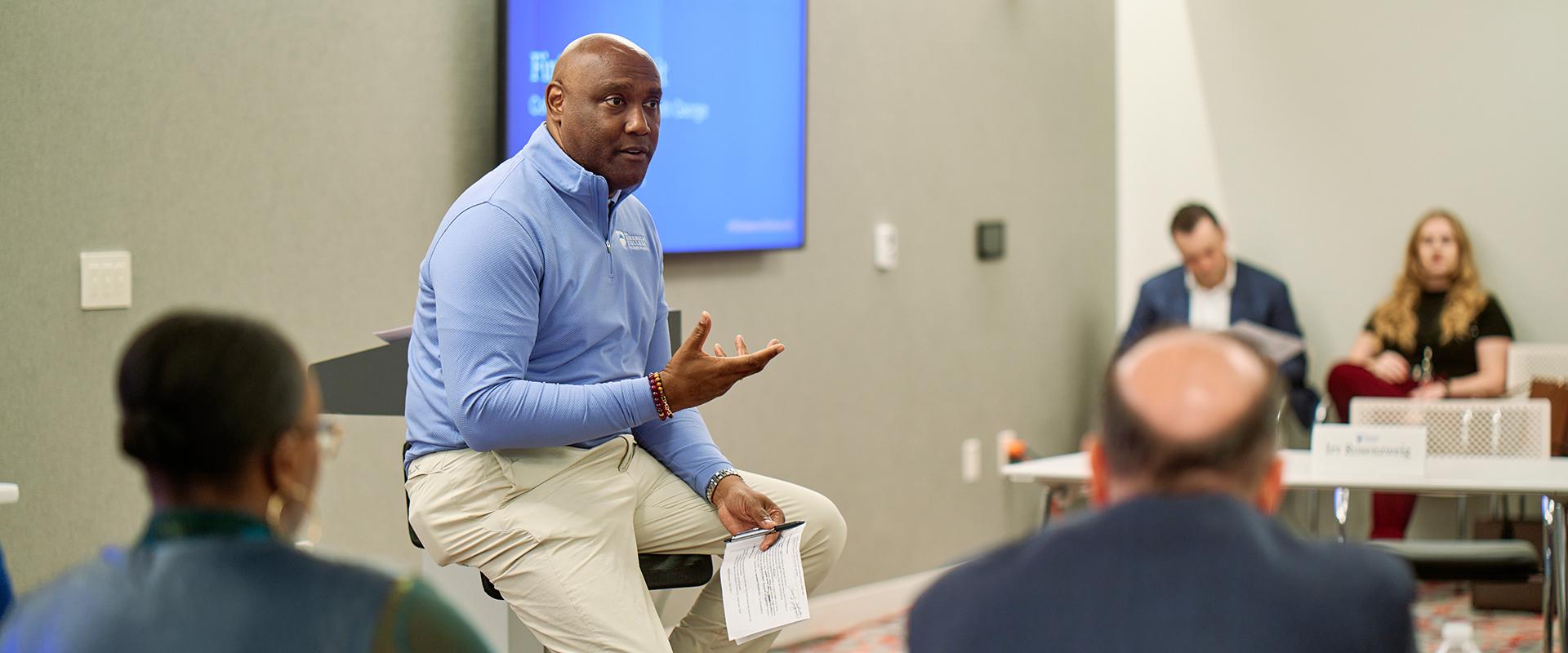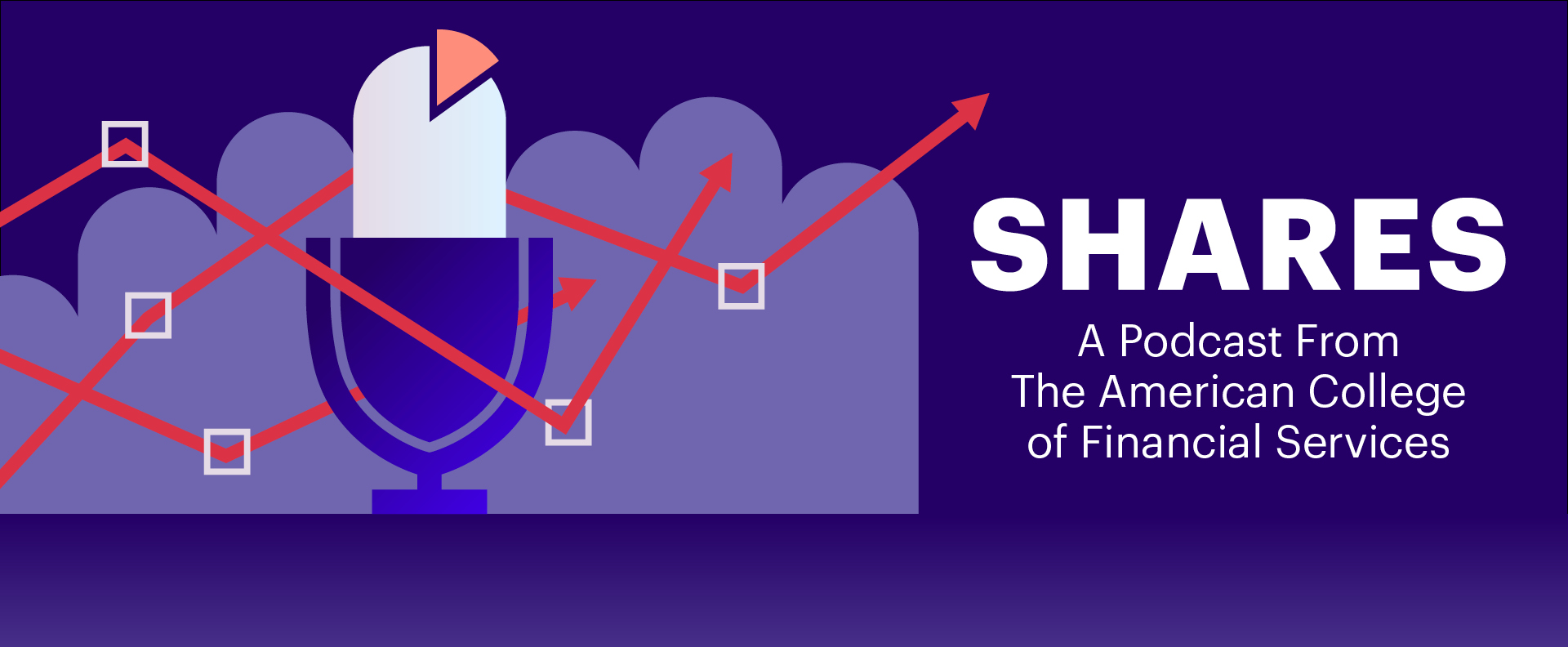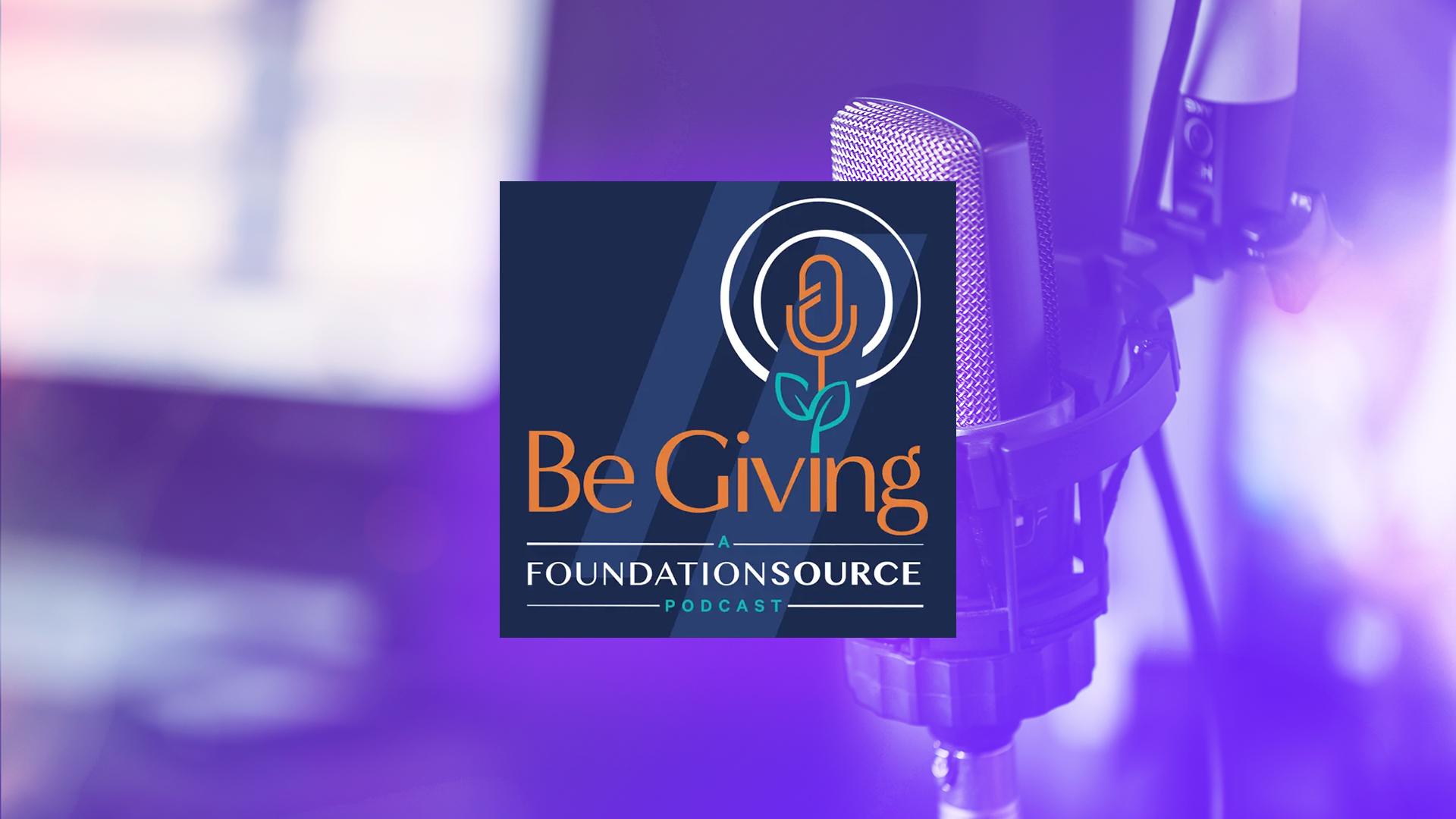Philanthropic Planning Insights
Discussing Donor-Advised Funds at FinServe Summit

Joining President Nichols for the panel discussion were FinServe Network ambassadors Rick Peck, CFP®, ChFC®, CAP®, an independent philanthropy consultant, and Mary Fischer-Nassib, CAP®, co-founder and CEO of the charitable organization Sow Good Now. Both ambassadors came prepared to dive deep into donor-advised funds (DAFs), one of the biggest trending topics in the philanthropic planning space today. A DAF is an account where an individual can deposit assets for donation to charity over time, recommending how to invest the assets or where to donate them and perhaps having a sponsor organization manage the account. DAF owners can also claim a tax deduction for making contributions to the fund each year.
While Nichols acknowledges there are many ways to give, including through checkbook giving or private foundations, he says he is amazed by how simple it is to set up a DAF today and how popular they are becoming. Peck credits these funds’ popularity with their ability to bypass complex giving schemes and make charity easy.
“DAFs used to have a $5,000 minimum threshold; now it’s $0, which makes them far more accessible,” he said. “People can give to others’ DAFs if they don’t want to create their own, costs are generally low, and there are many different investment or giving choices: you can set money aside in a DAF but delay the giving until you really want to do it.”
How to Use Donor-Advised Funds
While both Peck and Fischer-Nassib say they work with DAFs often in their businesses, the industry still needs to understand how to work with them more effectively.
“About 30% of the gifts we see today come from DAFs, but only 15% of nonprofits are set up to accept non-cash assets through DAFs; the problem is that non-cash assets are actually the majority of assets we see transferred,” Fischer-Nassib said. “We as an industry need to get educated, comfortable, and confident on how to use DAFs because they’re growing in popularity.”
Peck agrees with her assessment. “A lot of nonprofits are asking for cash only, even though most people aren’t in a position to give cash,” he said. “Instead, most people want to give other things: retirement plans and real estate; stocks, bonds, or mutual funds; cash value of life insurance; and personal property. Many nonprofits aren’t comfortable taking those because they’re not as easy to tabulate, but those gifts capture a lot of wealth that might not otherwise be going to charity.”
The ambassadors emphasize that there may be a steep learning curve for financial professionals who are unfamiliar with DAFs or charitable giving in general, but that the importance of understanding them justifies the investment of time. They say DAFs are a tool that can be used in many different professions and areas of financial planning and that they are one of the most effective, efficient, and powerful tools in a planner’s arsenal.
Regulating Donor-Advised Funds
President Nichols and the ambassadors also discussed the controversies surrounding DAFs, mainly consisting of unclear or inconsistent regulation and a public relations issue where some may see DAFs as hoarding vehicles: an avenue to avoid taxes by hiding away money but never using it to give. Peck, however, says this perception is unfounded.
“We actually see over 20% of DAF funds being distributed to communities and charities, with about $300 billion in all the DAFs out there,” he said. “In contrast, private foundations have $1.3 trillion all told, and yet they only distribute about 6% on average. There’s really no contest as to which is giving out more.”
However, the ambassadors did acknowledge the fiduciary uncertainty surrounding regulation of DAFs and how the financial services industry should approach using them. They say financial professionals have often been on the sidelines when it comes to managing DAFs and not intimately involved with the actual process of giving — something they hope will change given more education on the subject.
“If nonprofits are seeking funding and can’t get it through traditional sources, The College should get involved with educating people on how DAFs can be useful,” Fischer-Nassib said. “As a nonprofit leader, I’m looking for gifts given over several years, which DAFs are very useful for. They give you more muscle as a donor and more potential support from nonprofits as an advisor.”
In conclusion, our ambassadors say education is key to combating misconceptions about DAFs and other methods of philanthropic planning, as is recognizing the many different ways people can give — from their time and talent to treasure, testimony, and other methods. They say a more modern conception of giving is needed to encompass all the alternatives financial professionals have and the good they can do.
“Much of traditional philanthropy is top-down: people tell an underserved community what they’re going to do for them, or what they’re allowed to do with the money they’re given,” Fischer-Nassib said. “But if we really believe in those communities and want to give them resources but let them make their own decisions about what they need to thrive and succeed, DAFs are one of the best ways to make that happen.”
More From The College
- Meet Our FinServe Network
- Learn About Our Donor-Advised Fund Professional Certificate Program
- Learn About Our Chartered Advisor in Philanthropy® (CAP®) Designation
Philanthropic Planning Insights
CAP Groups Are Fueling Philanthropic Communities

For many designations available at The College, the most apparent benefits are conferred upon the advisor who earns the designation. Higher earnings, rates of referral, and increased trust by clients are prominent among these benefits. One could also determine a high level of benefit is received by the advisor’s clients. They receive a greater level of expertise, and as such should achieve improved outcomes. However, some advisors are aiming for another goal: improving their entire community.
The Founding of CAP® Study Groups
One such advisor, Mark Weber, CLU®, ChFC®, CAP®, MSFS, serves as a philanthropic consultant with Legacy Spectrum Advisor. Based out of Omaha, Nebraska, Weber sought to “make Omaha more generous.” With help from the Omaha Community Foundation, Weber founded one of the first CAP® study groups in 2012. According to Weber, the idea was derived from Todd Healy, MSW®, CLU®, ChFC®, AEP®, CAP®, who founded the first CAP® study group in Dallas, Texas, just one year earlier. Weber stated the original intent of the study group was to form a group of CAP® participants that could help each other maintain accountability as they worked to stick with the program.
However, this organization turned into something much more than the “study group” name would imply. Weber’s study group offered CAP® participants opportunities for additional learning outside the CAP® curriculum. This included guest speakers who would serve as supplements to the learning materials, social events that allowed for networking with other local advisors in the field, and meetings with major philanthropists. All of these activities, along with actual meetings to review the CAP® course materials, created a group of advisors committed to the cause of philanthropy in Omaha. In fact, many of these advisors continue to participate in study groups past the point of earning their CAP® designation.
Weber’s study group resulted in several tangible benefits as well; not just for its members, but for the Omaha community. According to Weber, his study group boasts a 100% graduation rate from the CAP® program. Weber also shared that participants in the CAP® study group program refer three funds on average to the Omaha Community Foundation. In comparison, non-CAP® advisors average only one referral. Weber also stated that in 2023, the average size of an account opened with the Omaha Community Foundation by a CAP® advisor is about seven times larger than the average of a non-CAP® advisor.
To further measure the impact of the CAP® study group on the Omaha community, the study group conducted its own survey among 80 attorneys, accountants, and wealth managers that had completed the program. Weber stated, “They were asked to isolate those client situations where their involvement may have favorably disposed their client to make a charitable gift, and then, on a no-name basis, indicate the approximate dollar amount of the gift and whether it is a current gift, beneficiary designation, (or) bequest by will … Their responses indicated the total amount of gifts, current and anticipated, exceeded $9 billion. It was the first quantitative evidence we had that we were truly making a difference in our community.”
Making a Difference on the Community
Aside from this quantitative proof, Weber pointed out several aspects of the philanthropic community forming in Omaha he believes serve as qualitative proof of the CAP® study group’s impact. Weber stated, “For years, people could have multiple advisors who never met with each other.” However, with the popularity of the CAP® study group, Omaha’s philanthropic scene has benefited from an uptick in advisor collaboration. By networking and studying together, philanthropic advisors in the community have come to know one another, share effective strategies with each other, and work together to help clients reach their financial goals. Thanks to these results present in his own community, Weber has expressed the belief that “The CAP® Program has the potential to have a national impact on charitable giving seen in cities throughout the country.”
CAP® Communities in Florida
To Weber’s point, other CAP® study groups have sprung up across the country. One such group emerged in Central Florida after its founder, Kimberlee Riley, CAP®, heard about Weber’s study group and was inspired to make a similar difference in her own philanthropic community.
Citing a desire to be part of a team that supports the aspirations of donors, Riley developed the group to aid in the professional development of philanthropic advisors in the area. Requiring donor-facing advisors in her organization to take part in the program, Riley’s study group provides participants with opportunities such as guest speakers and networking opportunities known as “NightCAPs.”
Riley has also used her CAP® study group to bring together multiple disciplines so they can share their unique perspectives with one another. When discussing the benefits of the program, Riley stated, “It enhances the opportunity for the student to get the experience they might not during self-study, and those relationships are there for life.”
“It enhances the opportunity for the student to get the experience they might not during self-study, and those relationships are there for life.”
Building Better Relationships
By combining the perspectives of professionals from across the field of philanthropy, specifically those of nonprofit, financial, and legal professionals, Riley believes the members of her CAP® study group are able to develop a stronger understanding of their clients and their goals, ultimately building stronger client relationships and empowering them to approach their clients’ situations using a greater number of methods. As Riley states, the marriage of these perspectives “is so focused on values and making sure you’re guiding your clients based on those values.” By considering each of these unique viewpoints when working with clients, Riley believes study group participants not only build better relationships with clients, but also with their families. As such, Riley’s study group has made a large difference of its own to the Central Florida philanthropic community.
By coming together, Riley believes her study group has made a significant emphasis on the team element of being a philanthropic advisor. By increasing the number of philanthropic professionals bearing the CAP® designation in her region by over 60%1, Riley has cultivated a community in which advisors can collaborate, share tips, and help each other meet their professional goals.
In both situations, CAP® study group members have come together to better their community, improving outcomes for their clients through collaborative learning and a deep commitment to their cause. As Weber stated, “In Omaha, when people say they’re a CAP®, that’s a badge of honor.” With the difference holders of the CAP® are making in their communities, it isn’t hard to see why.
More From The College:
Philanthropic Planning Podcasts
Making an Impact Through Philanthropic Planning

In this episode of our Shares podcast, host Joellen Meckley, JD, MHS, ChSNC® joins Andrew Tudor, CFP®, RICP®, CAP® for a conversation on the options that exist today for powering philanthropic planning including donor-advised funds (DAFs), and the importance of adding charitable giving to your client conversations.
Andrew Tudor, CFP®, RICP®, CAP® is a financial services professional, a popular speaker, and an investment advisor with Zenith Wealth Partners, as well as an ambassador for The College’s FinServe Network. He is passionate about empowering women and black families to transform their relationship with money. After beginning his career in banking, Tudor made the transition to financial planning where he has helped many clients achieve financial freedom through a combination of strategic planning and empathetic coaching. He has spoken at numerous conferences, panels, and keynotes across the U.S. He is known for his unique speaking style of storytelling and humor, and provides audiences with one-of-a-kind perspectives on money stories, the racial and gender wealth gap, and practical tools for building wealth.
Any views or opinions expressed in this podcast are the hosts’ and guests' own and do not necessarily represent those of The American College of Financial Services.
More From The College:
- Learn More About the American College Center for Philanthropy and Social Impact
- Get Started with Our Chartered Advisor in Philanthropy® (CAP®) Program
Philanthropic Planning Insights
Planned Giving With an Impact

Many of these decisions relating to lifetime giving and planned giving can be paralyzing, and several people opt to avoid the process altogether. Fortunately, there are several methods that can be leveraged to maximize the impact of these gifts whether they be to individuals or charities, including some new opportunities as a result of the SECURE 2.0 Act.
Lifetime Giving
While the focus of this article is primarily on planned giving, lifetime giving can confer many benefits onto donors as well. Specifically, lifetime giving provides a good method of spending down an estate, especially for those who need to do so for estate tax planning purposes. It’s also worth considering that the Tax Cuts and Jobs Act (TCJA) is scheduled to sunset at the end of 2025, which would lower the estate lifetime exemption amount to $5 million indexed for inflation. By giving up to $18,000 per donor per year to individuals, plus charitable donations, which create an income tax deduction for those who itemize, high-net-worth individuals can spend down their estates.
Additionally, gifts during life can be monitored and questions can be answered with appropriate insight to the original intent should they arise. Gifts to individuals upon one’s passing result in a step up in basis for the heir and long-term holding, even if sold that day. Gifts to charities upon one’s passing result in an estate tax deduction for those with large enough estates. Thus, the decision whether to give gifts during life versus at death involves balancing and weighing many factors. The “best” option is often some combination of the two, but is ultimately determined on a case-by-case basis.
Charitable Gift Annuities
The first high-impact planned gift to consider is a charitable gift annuity (CGA). CGAs were voted “best planned gift” by the Stelter Group two years in a row. We have known about qualified charitable distributions (QCDs) for a while, up to $100,000 per year, for those over the age of 70.5. The SECURE 2.0 Act added to this provision and now allows a one-time QCD election from an individual retirement account (IRA) to a CGA of up to $53,000 in 2024. RMDs are taxable events, while these QCDs are not, creating an income tax savings. CGA rates have been increasing, resulting in higher payout amounts for the donor and guaranteed lifetime income while benefiting charity at the same time.
Donor-Advised Funds
Another high-impact gift to consider is a donor-advised fund (DAF). These funds are versatile, allowing donors to direct the funds to charity when, where, and how they want, while receiving the income tax deduction in the year the money is put into the DAF.
This flexibility allows donors to frontload multiple years of charitable donations to itemize in one year, and take the very high standard deduction in other years. Thus, a donor can front-load multiple years worth of donations into a DAF and achieve a higher deduction than the standard while simply opting for the standard deduction in other years.
Appreciated Stock
The final high-impact gift to discuss is appreciated stock that has been held for more than a year. Gifts of appreciated stock result in an income tax deduction in the year of the donation, plus avoidance of capital gains taxes that would be paid in the year of a sale. In the event of a capital loss, sell the asset, claim the capital loss, donate the remainder, and take the charitable deduction.
If these stocks are in an IRA, and the donor is at least 70.5 years of age, keep in mind that with the passage of the SECURE Act, Stretch IRAs are not allowed anymore for inherited IRAs. They must be liquidated within 10 years. These events trigger ordinary income tax liability for the heir. Donating stock or an IRA to a charity avoids this, and taking advantage of the QCD during one’s lifetime after age 70.5 can help spend down the estate with an asset that has fewer inheritance benefits than in the past. In fact, for some people, the tax liability on the RMD would be considered a hardship or inconvenience, not to mention the burden of not messing up and forgetting to take the RMD. Although the SECURE 2.0 Act gradually increases the age for RMDs, the act did not change the QCD eligibility age from 70.5. Thus, a donor can take advantage of QCDs before they are required to take their RMDs.
Other Methods
In addition to these high-impact gifts, individuals should still consider the more traditional charitable bequests via will or trust, life insurance, retirement assets, payable on death/transfer on death, and a life estate, all taking effect after death. Life insurance, retirement, and POD/TOD beneficiaries are relatively easy to set up and usually at no cost. A will, trust, or life estate may require an attorney to draft the documents, so the cost is higher, but still a great option for many people. These gifts can be used effectively in combination with one another.
This article is adapted from an article that originally appeared in “Planned Giving Today.”
More From The College
- Learn More About DAF
- Gain philanthropic and legacy planning knowledge with our CAP® Program
- Learn about the American College Center for Philanthropy and Social Impact
Philanthropic Planning Insights
Discovering the Realities of Planned Giving

Steven L. Meyer, PhD, author of Personalized Philanthropy: Crash the Fundraising Matrix, recently sat down with Chartered Advisor in Philanthropy® (CAP®) Program Director and Assistant Professor of Philanthropy Jennifer Lehman PhD, JD, CFP®, CAP® to discuss his thoughts on charitable giving and how advisors can deviate from standard ways of thinking to achieve better outcomes.
Escaping the Matrix
Lehman begins her conversation with Meyers by asking him about his inspiration for writing Personalized Philanthropy: Crash the Fundraising Matrix. Meyers responds by saying, “I wanted to share these incredible stories that I had picked up…and the experiences, and along the way I felt that I had kind of redefined the way that I was thinking about philanthropy and fundraising.”
Meyers then goes on to explain his process for writing the book, stating that one of his first challenges was what he would name it. Meyers cites inspiration from the movie The Matrix, stating, “The book and the movie are both about this process…of waking up and…gaining your superpowers as you find your voice, and you find these strategies that will work for you and allow you to thrive in an environment where a lot of people have very difficult times.”
Killer Apps
As their conversation continues, Lehman asks Meyers about his “killer apps.” These personalized plans, according to Meyers, empower all donors to qualify as “major donors,” with far greater impact than they may initially envision.
In reference to the “killer apps,” Meyers states, “Instead of…viewing donors as having just a transactional capacity, you think about them in terms of their total lifetime value.”
Meyers offers his idea of the “philanthropic mortgage” as the best means of visualizing this concept. As he explains, “When you buy a house, you don't have to wait till it's completely fully paid for. You start living there and enjoying the benefit of your house right away. So why can't we think about a gift in that same way, or an endowment in particular?”
When discussing step-up gifts, another of Meyers’ “killer apps,” Lehman points out this option may be favorable to younger donors, stating, “That could work really well for a young professional: somebody early in their career, and it gets that philanthropic mindset going where they are giving a little each year – and then, whether it's every year or every few years, they step it up a little bit.”
Meyers supports this point, sharing a personal anecdote of a young donor being able to see the fruits of his gift realized by giving through a step-up gift plan. Meyers touts this as one of the top benefits of step-up gifts.
Thinking Creatively
After discussing several of these unconventional ideas with Meyers, Lehman points out the importance of thinking creatively in philanthropic giving. She asserts that by approaching donors and expecting them to have cash assets at the point in time the gift is planned, many potential donors can be eliminated from the pool as compared to the amount of donors that may be able to provide gifts through alternative methods, such as virtual endowments and non-cash assets.
Lehman goes on to discuss more creative methods of planning charitable gifts and the concepts behind them. To learn more about these methods of planned giving, the full discussion can be viewed in Knowledge Hub.
More From The College
- Gain philanthropic and legacy planning knowledge with our CAP® Program
- Learn about the American College Center for Philanthropy and Social Impact
Ethics In Financial Services Philanthropic Planning Insights
Ethics Through the Lens of Philanthropic Planning

Managing director of the American College Cary M. Maguire Center for Ethics in Financial Services, Azish Filabi, JD, MA sits down with The College’s Chartered Advisor in Philanthropy® (CAP®) Program director and assistant professor of philanthropy Jennifer Lehman PhD, JD, CFP®, CAP® to discuss the ethical considerations advisors and other financial professionals must make when offering philanthropic planning services in a new continuing education (CE) opportunity available on Knowledge Hub+.
Filabi kicks off the discussion by reflecting on her history as a professional, stating that she has always worked to ensure organizations have the right governance structures in place and the right tools in place so they can consider ethics in their own personal decision-making as well as the impact they’re having on society.
She goes on to discuss the work performed at the Center for Ethics in Financial Services, stating the importance of the group’s research mission and outreach. In reference to this research, Filabi explains the purpose as “learning about the challenges that leaders and individuals are facing with respect to ethics so that can reflect back on the work that we do.” By completing this research, Filabi believes that the Center for Ethics will be able to provide the industry with valuable lessons relating to ethical concerns in the field.
Trust in Financial Services
One of these key lessons focuses on the topic of trust in financial services. Filabi shares that “Everyone I talk to highlighted trust as being a key factor in effective work that we do because it's essentially the glue that brings it all together. Some people went as far as to say that they're not in the business of selling financial products. They're selling trust because people have to trust us as professionals to be able to have their money in our good hands. Because trust is so important to financial services, the Center offers a certificate program on Advanced Strategies for Building Trust to help leaders access tools and frameworks to address this challenge.”
Lehman ties this back to the mission of The American College of Financial Services as a whole, stating a goal of providing applied financial knowledge and education, promoting lifelong learning, and advocating for ethical standards to benefit society. As Lehman points out, philanthropy is a key part of the profession tied to social impact.
Filabi weighs in on this, providing a description of ethics in the industry. She emphasizes the importance of doing no harm and acting in accordance with legal requirements while navigating opportunities. However, she points out that this is a more simplistic view on ethics. When providing her perspective, she states, “We at the center like to think about ethics, not only about the compliance and legal challenges that people face in their day to day, but about the gap between these minimum standards that are expected of us and the day to day challenges that people face in their work…what is the standard that clients expect from you so that they can trust you that might not already be codified in the law?”
How Do We View Ethics in the Context of Philanthropy?
Filabi continues by tying this to the field of philanthropy, discussing concepts such as conflicts of interest, duty of care, and loyalty. She admits this to be a challenging balancing act that also requires financial professionals to consider social impact as part of the equation.
Filabi contends that the importance of social impact is especially critical for the philanthropic sector in recent years. She supports this assertion by stating, “Government budgets are really crunched, and so that means that the philanthropic sector is playing a huge role in addressing some of the business and (societal) challenges that we face in the economy, and I think that should be part of an understanding of ethical duties and obligations as we think about social impact.”
“Government budgets are really crunched, and so that means that the philanthropic sector is playing a huge role in addressing some of the business and (societal) challenges that we face in the economy, and I think that should be part of an understanding of ethical duties and obligations as we think about social impact.”
Lehman and Filabi go on to discuss several additional topics relating to ethics in the philanthropic sector including the Donor Bill of Rights, what an organization should do if a donor’s values don’t align with the organization’s values, key items to consider when weighing the ethical implications of our choices, and more in this discussion, available exclusively on Knowledge Hub+!
To access this learning opportunity and other valuable CE, visit Knowledge Hub+.
More From The College:
- Gain philanthropic and legacy planning knowledge with our CAP® Program.
- Learn about the American College Center for Philanthropy and Social Impact.
- Join the waitlist to be notified when enrollment opens for the TPCP™ Program.
- Learn about the American College Cary M. Maguire Center for Ethics in Financial Services.
Philanthropic Planning Insights
Making a Tax Plan for Planned Giving

Join The College’s Chartered Advisor in Philanthropy® (CAP®) Program Director and Assistant Professor of Philanthropy Jennifer Lehman PhD, JD, CFP®, CAP®, as she discusses how to account for tax consequences when assisting clients in making charitable contributions and other forms of planned giving in this new continuing education (CE) opportunity available on Knowledge Hub+!
Whether you’re a financial advisor or a professional representing any other area of the philanthropic advising ecosystem, you should be familiar with tax regulations in order to assist clients as they devise their strategies for planned giving. The College and charitable giving expert, Jennifer Lehman provide key details in Planned Giving: Fun with Taxes and Probate.
What is Probate?
Lehman begins this discussion by explaining the concept of probate to listeners. “Probate is a legal process … that transfers property after somebody’s passing.” Probate is meant to re-title assets that are not already re-titled through some other method (such as a valid beneficiary or automatic survivorship).
However, not all cases in which the transfer of property occurs involve the process of probate. Some smaller families without significant assets may simply agree on how to divide an individual member’s wealth after their passing.
Probate can also differ on a case-by-case basis. Lehman goes on to discuss how probate looks when an individual dies with a will in place and compares the differences in the process when an individual dies without one. She also describes what parts make up this process and what participants can expect.
Lehman goes on to share her major takeaway that provides a high-level understanding of people’s relationship with probate. According to Lehman, probate is an expensive and onerous process. “It is a process that people like to avoid. So, the way to avoid probate is to plan during life for what will happen to your things when you pass.”
Giving During Life vs. After Death
Lehman discusses several methods of planned giving that clients may want to consider, starting with giving to individuals, such as a family member, and the differences between giving during life and giving after death. She emphasizes several important factors to consider, including step-s up in basis, long-term holdings, and annual gift tax exclusions, among others.
However, one key factor cannot be optimized for the best tax situation. Lehman reminds advisors, “The downside in waiting until death is you don’t get to see the benefit to the individuals or the charity as far as how they use the money and what they do with it.” This can be a major deciding factor for some clients, as they may like to see the benefits of their giving before passing away.
Gifts Your Clients May Want to Consider
Lehman highlights several forms a client’s gift may take, including gifts that can take effect during life such as cash, donor advised funds (DAFs), stocks and bonds, real estate, and qualified charitable distributions (QCDs). She continues by comparing these types of gifts to gifts that can be planned in life, but do not take effect until death, such as retirement assets, life insurance, life estate, DAFs, and individual retirement accounts (IRAs).
For continued giving, clients may also want to consider gifts that generate income such as annuities, remainder trusts, and lead trusts. These allow clients to impact their recipient of choice for years to come rather than as a single transaction.
All of these gifts have various factors to consider, and the best choice may not be the same from one client to another. By mastering the principles Lehman shares in this discussion and following her guidance when offering clients recommendations, advisors can help their clients achieve all of their gift-giving goals and more. She elaborates on these in greater detail in Planned Giving: Fun with Taxes and Probate on Knowledge Hub+.
To access this learning opportunity and other valuable CE, visit Knowledge Hub+.
More From The College
Gain philanthropic and legacy planning knowledge with our CAP® Program.
Learn about the American College Center for Philanthropy and Social Impact.
Join the waitlist to be notified when enrollment opens for the TPCP™ Program.
Financial Planning Philanthropic Planning Retirement Planning Insights
FinServe Ambassador Charts Career Evolution Through Specialization

Tudor says he entered the financial services profession via banking in 2008 during a volatile and chaotic time for the industry. Despite this, he says he found great satisfaction in his work in leadership roles – running several bank branches around Cincinnati, Ohio – and especially in areas involving lending. That was where he first started to sense the industry might have blind spots and think about how he wanted to address them.
“I really enjoyed helping people buy houses and start small businesses, but I saw gaps in knowledge and access, especially when it came to investment management,” he said. “The bank often had a minimum level of assets they would service, and I often saw more resources being afforded to affluent communities. I knew I wanted to focus on those who had been historically excluded.”
Tudor eventually transitioned into a role with Northwestern Mutual and spent several years at the company becoming a licensed advisor and directly working with clients. From those interactions, he continued to refine his sense of who he was as a professional and who he wanted to serve.
“Most people, especially those from historically excluded communities, need more education in and access to financial services and are looking for deeper advice than just receiving products,” he said. “I’ve always felt we should be building in systems to protect and educate these groups.”
In 2020, amid the COVID-19 pandemic, Tudor finally decided he wanted to start his own firm and launched Alchemist Wealth – with a focus on fee-only planning and serving women and other historically excluded communities – with his brother. Four years later, he merged the successful practice into Zenith Wealth Partners, where he continues to work as an advisor in a variety of planning fields, from investment portfolios to retirement and philanthropic planning. It’s all in service, he says, of his mission to help his clients align their money with their values.
The Role of Retirement Planning
While at Northwestern, Tudor availed himself of the company’s connection to The College to earn multiple designations and certifications: first through the CFP® Certification Education Program to get a strong financial planning foundation, and later through the Retirement Income Certified Professional® (RICP®) Program for the specialization he was seeking in retirement preparation and planning.
“The first time a client came to me and asked me questions about retirement I couldn’t answer, I knew I had to get more knowledge,” he said. “The RICP® is powerful because it impresses upon you that accumulation planning and retirement income planning are two very different things. When I was at Northwestern, we would answer questions about retirement planning with material from College thought leaders like Michael Finke, PhD, CFP® and Wade Pfau, PhD, CFA, RICP®. Their advice on using tools like annuities, home equity, and other income streams to stabilize retirement income may not be popular in some circles, but they’re mathematically proven to be better solutions.”
“[The RICP® Program]’s advice on using tools like annuities, home equity, and other income streams to stabilize retirement income may not be popular in some circles, but they’re mathematically proven to be better solutions.”
Tudor says thanks to the RICP®, he is now well-versed in retirement planning concepts and can simplify them enough for his clients to understand. He also says he sees a growing need for this specialized knowledge as America continues to age.
“The industry to me is still five to 10 years behind what’s necessary in retirement income planning, and it’s exciting to see The College continue to be out in front of the latest ideas and blaze the trail for doing things the right way,” he said.
Investing for Impact
In addition to his focus on retirement planning, Tudor says he’s always been interested in the technical side of planning and the potential of money in general to benefit society. Because of this, he enrolled in the Chartered Advisor in Philanthropy® (CAP®) Program at The College to gain more specific knowledge about how to use investment strategies to help his clients live their values.
“We often ask clients about their goals for impact: whether they’re broad or specific, for family, community, globally, or causes they support,” he said. “Clients constantly bring these subjects up, and I don’t know how I would be an advisor without being able to have those conversations. I believe eventually those kinds of conversations will be table stakes for the industry, and everyone will need to know how to talk about charitable giving with clients and organizations.”
While he loves working directly with clients, Tudor says it’s the institutional side of giving that he’s fallen in love with thanks to the CAP® Program.
“It’s about how you use money and make it work for what you believe in the real world, not just on your spreadsheet,” he said. “That kind of mission-aligned investing, where organizations use their capital to benefit society, is exactly where I want to be. The CAP® Program’s donor strategies were helpful, but its full course dedicated to working with nonprofits has allowed me to sit on board committees and lead conversations about aligning investment portfolios with an organization’s mission. I think that’s a serious gap in the market to be addressed.”
“[The CAP® Program] has allowed me to sit on board committees and lead conversations about aligning investment portfolios with an organization’s mission. I think that’s a serious gap in the market to be addressed.”
Finding Community and Purpose
After being inaugurated into The College community as a recipient of the NextGen Financial Services Professional Award, Tudor says he has been consistently impressed by what The College is able to do for financial professionals – especially in its events like the annual Conference of African American Financial Professionals (CAAFP).
“CAAFP feels like a homecoming every year for me,” he said. “It’s my one opportunity to see and reconnect with a lot of people I know from the industry, and the workshop and keynote sessions are consistently incredible. It’s a safe bet for me to invite a new advisor to CAAFP. There aren’t many places Black professionals in financial services can go and see mostly people who look like them, and the level of excellence in the execution of the event is always impressive.”
“It’s a safe bet for me to invite a new advisor to CAAFP. There aren’t many places Black professionals in financial services can go and see mostly people who look like them.”
Tudor says he’ll be present at this year’s CAAFP, to be held August 12-14 in Atlanta, Georgia. In the meantime, he advises young professionals in the field to be open to challenging themselves and thinking intentionally about their career path.
“Go to places that stretch you and be mindful of how you feel when you’re doing things,” he said. “This field affords you 40 years to build a career and have an impact, so thinking long-term is key. I love working with personal clients and enjoy financial planning in general, but I really live for doing organizational and institutional planning. Fill your day with things you enjoy doing, and success will come.”
Philanthropic Planning Insights
Dien Yuen Joins the Be Giving Podcast

Dien Yuen, former executive director of the American College Center for Philanthropy and Social Impact, was recently a guest on the Be Giving podcast hosted by Elizabeth Wong.
In this episode, Yuen joins Wong to share her expertise in the field, discussing topics such as the importance of philanthropy in wealth management, the value placed on philanthropy by The College and the Chartered Advisor in Philanthropy® (CAP®) Program, and the unique experiences faced by advisors of color.
Hear about these topics and more in this informative and thought-provoking discussion as Yuen shares her experiences with The College.